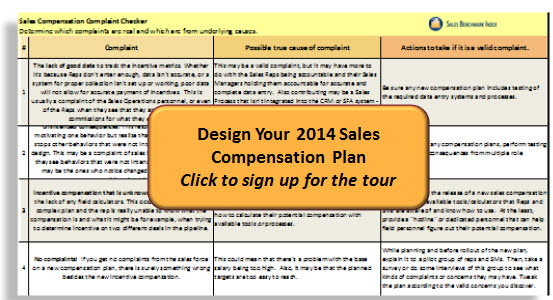This post is for Sales and HR Leaders planning 2014 Sales Compensation. It provides a number of common Sales Compensation complaints. Knowing these complaints, you can build your 2014 plan to avoid them. I also discuss some underlying causes of the complaints that may not be compensation-related.
Something you’ll need to go with this post is the Sales Compensation Complaint Checker. It describes over 10 complaints Sales forces have on sales comp. Each complaint also has the potential root causes as well as planning advice. To get this tool, sign-up here. This also gets you access to SBI’s Annual Sales & Marketing Research. At no cost, an expert from SBI will present the full research findings. You will get access to more guides and tools to help sales compensation planning.
Let’s say sales weren’t spectacular in 2013. You’ve done some analysis and want to change sales compensation. Hopefully, your analysis included gathering complaints from the sales force. Here are 3 common sales compensation complaints, their possible causes and advice to fix. The Sales Compensation Complaint Checker has 8 more.
Complaint #1: No complaints!
If you get no complaints from the sales force on a new compensation plan, take note! Surely something is wrong besides the new incentive compensation. Especially if the number of sales reps hitting quota is usually low. This could mean your base salary is too high. Or there may not be enough leverage in the current On Target Earnings. Another cause may be that the targets are too easy to reach. Naturally, Reps won’t complain about that. On the contrary, it may be that Reps are resigned to not making quotas. This might stem from the same approach year after year – an approach that set targets too high to achieve. Reps give up and learn to live off of base salary.
While planning and before rollout of the new plan, explain it to a pilot group of reps and SMs. Then, take a survey or do some interviews of this group to see what kinds of complaints or concerns they may have. Tweak the plan according to the valid concerns you discover. Also look at the historical approaches used to plan sales compensation. If it’s been the same year after year, it might be time to shake things up.
Complaint #2: Compensation is based on someone else’s performance!
Incentive targets are linked in a competitive fashion, not on my own improvement. Some firms may use competitive ranking for parts of incentive compensation, or for the illustrious “President’s Club”. Reps would rather compete against a standard (like 150% of a standard target) or even against their own historical performance rather than against a peer who “had a bunch of bluebirds or an easy territory.” Granted, all things being equal, using competitive rankings may work. But usually, all things will not be equal in the B2B world.
This may very well be a real complaint. However, look out for those who just are not as talented as their peers. Territory design and account assignments could also be a cause. That’s because a Rep may not have as competitive of a territory as peers.
When having targets for President’s Club or some other high-privilege reward, consider setting the target against the own Rep’s performance. For example, use year over year growth as a yardstick or an increase in the number of deals over the past year. Ensure that quality is also a factor that improves for the Rep. You may even add factors for a Rep’s improvement in sales competencies.
Complaint #3: The Plans Come Out Too Late!
For example, “The selling year starts on Jan 1, but I don’t know what I’m going to be paid until the plan comes out in March.” Some firms act so late because they are actually waiting to get the final results from the previous year. The delays are often caused by internal debates over all the moving parts. Finally, targets are set against the performance attained. An example: Product Marketing provides funds to incent sales of their specific product. But, they are late finalizing how much they will fund.
There may not be many underlying reasons for this complaint. However there may be a ton of reasons why the plans are actually late. Flawed territory design is one possible underlying reason. Accounts and territories are not methodically analyzed. This means true potential is unknown, so the simpler method is used – a flat percentage is tacked on to the previous year’s number.
Work on your annual sales comp planning process. Ask a question at the end of the first half year, if not sooner. “Do we need to change the comp plan?” If no, ask the question again at the end of the 3rd quarter. If yes, start your planning just after the 1st half ends. You should be able research the different factors that trigger a sales comp change. Things like market shifts, new product roadmaps, acquisitions, etc. Also, start doing a true analysis of territory and account potential. Base potential on ideal company profiles and propensity to buy factors. Mix this with market trend insights. If you need some insight on this kind of territory design, please contact us.
How to Build the 2014 Sales Comp Plan – and Prevent the Complaints
Here are 3 steps HR and Sales leaders can take to ensure the 2014 sales comp plan will succeed:
- Sign up for the SBI tour to get the Sales Compensation Complaint Checker
- Review the list in the tool of sales comp complaints and possible causes
- If not done already, gather complaints from the sales force on the compensation plan
- Use the advice in the tool to plan 2014’s compensation while addressing the complaint causes
If you don’t want to have a big complaints file, work on this now. It’s better to hear the complaints ahead of time. That way, you can build the plan to avoid the complaints.




